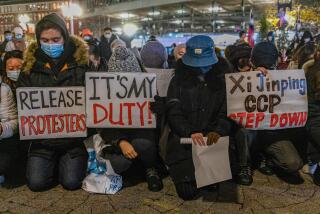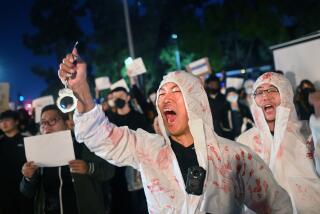Anaheim Man Sees Chinese Turmoil Firsthand : Banner Year Ends for Doctor
- Share via
A young Anaheim doctor’s round-the-world medical mission proved more exciting than he expected. It ended last week in Beijing, China--right in the middle of thousands of demonstrators.
There, Dr. Christopher Coad waded through throngs of banner-waving students. He watched as peaceful demonstrators offered ice cream and water to guards from the People’s Liberation Army.
And at central Beijing’s Tian An Men Square, he confessed to feeling a little “unnerved” when he discovered that he was one of “maybe four” Westerners among a million chanting people.
Sporting a black tie decorated with a fiery Chinese dragon, the 31-year-old ophthalmologist was relaxing Thursday at his parents’ Anaheim home after a yearlong fellowship with Project Orbis, a traveling eye clinic that is based inside a renovated DC-8.
As one of five eye doctors assigned to Orbis, Coad had spent the year performing surgeries and training foreign doctors in India, Nepal, Thailand, Bangladesh, New Guinea and the Philippines. Orbis’ last stop was a 3-week stay in Beijing.
But Coad, who was assigned to make final arrangements for that visit, arrived ahead of the rest of the team, on April 23, the same week the protests began.
Coad said he spent his first days in Beijing uneventfully, laying plans for medical lectures and eye surgeries. But on April 27, as he walked from his hotel to Tian An Men Square for a meeting, “I was caught up in the largest demonstration they had ever had.”
The main street, Changan Boulevard, was blocked off, Coad recalled. “No buses were moving. No pedicabs were moving. . . . It was just students marching with their banners.”
Trying not to become associated with the marchers, Coad worked his way to the square by walking alongside the students, then “climbing through gardens, over fences.”
At first, Coad said, the students were demanding only greater press freedom and their movement seemed to be pro-government. “It was a reformist movement, not a revolutionary movement,” he said.
But as the demonstrations continued, Coad said he watched the students begin to denounce hard-line Premier Li Peng and demand changes in government leadership.
At first, Coad said workers seemed unsympathetic to the demonstrations as did the Chinese doctors who worked with Orbis. “In the beginning, most people just ignored it,” he said.
But after several weeks, “the doctors were more supportive of the students. They still apologized for the inconvenience the demonstrators were causing, but they would start asking us what we thought of the democratic movement” in China, Coad said.
As he worked with Chinese doctors, and in his spare time toured the city, Coad said he found many more demonstrators. When he visited the Great Wall of China about 40 miles outside of Beijing, he passed marchers on their way to Tian An Men Square.
At ancient temples in Beijing and also in a section of the city called the Forbidden City, there were students carrying banners.
Coad said he visited the square for the last time on May 18. By then, students had begun a hunger strike and were finally receiving so much support, from workers, professionals, everyone, that “the entire city was immobile,” he said.
That day, as he walked through the square with another American from Project Orbis, “We gave support to the demonstrators,” Coad said. “We had seen a pro Sino-American banner, and you just kind of cheer.”
Coad left for Shanghai on May 19--”less than 24 hours before they declared martial law” in Beijing, he said. But even in Shanghai, more than 600 miles south of China’s capital, there were demonstrators. They blocked the road from the airport so that the doctor had to carry his luggage the half mile to his hotel.
Demonstrations continued every day that he was in Shanghai, Coad said. But “it wasn’t a scary movement--there was more of a festival atmosphere.”
When he finally left for Hong Kong, he found demonstrators there too--holding a sympathy demonstration for Chinese on the mainland.
On Thursday, Coad’s first day in Anaheim in a year, he said he was glad to be back.
“It’s very comforting to be home,” he said, and added: “I’d rather watch the movement from here.”
Still, Coad said he is amazed by his China experience.
“I was expecting a nice medical exchange--talking to doctors interested in learning new microsurgical techniques. But it was remarkable to be there at such a time,” he said. “You felt history was being made and you were right there.”
More to Read
Sign up for Essential California
The most important California stories and recommendations in your inbox every morning.
You may occasionally receive promotional content from the Los Angeles Times.













